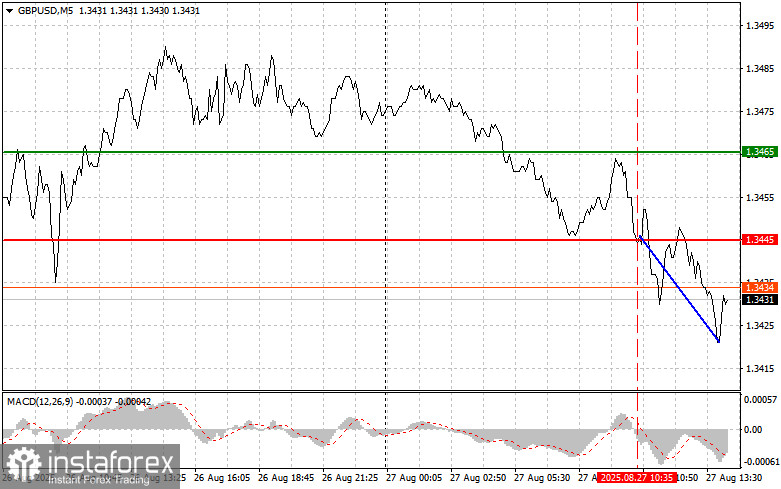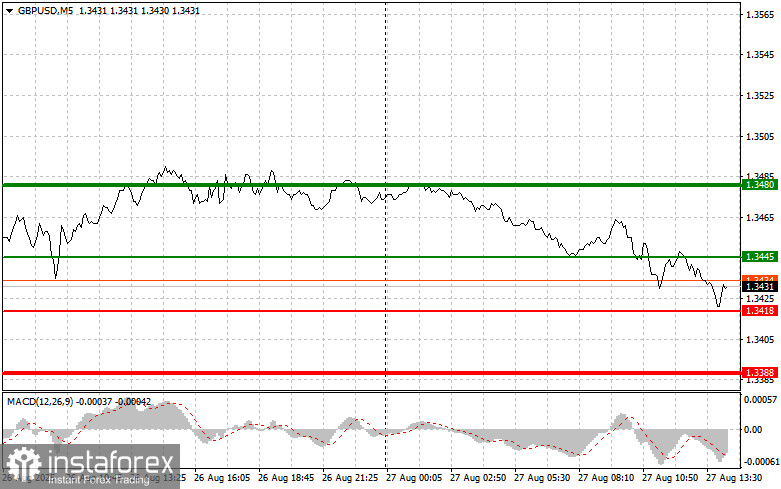Trade analysis and tips for trading the British pound
The price test of 1.3445 occurred when the MACD indicator had just started moving down from the zero mark, which confirmed the correct entry point for selling the pound. As a result, the pair fell by 25 points.
A weak retail sales report in the UK reinforced the decline in GBP/USD. Uncertainty regarding the Bank of England's future monetary policy, combined with worsening economic prospects for the UK, continues to exert bearish pressure on the British currency. Investors fear that the regulator, facing high inflation and recession risks, will be forced to take a more cautious stance on interest rates, which in turn reduces the attractiveness of the pound sterling.
During the U.S. session, no American statistics are scheduled, so the focus will shift to the speech by FOMC member Thomas Barkin. A hawkish tone from Barkin could place further pressure on GBP/USD. Investors are concerned that tough rhetoric, signaling a wait-and-see approach to interest rates, will strengthen the dollar and, as a result, increase downward pressure on GBP/USD.
As for intraday strategy, I will rely primarily on the implementation of Scenarios #1 and #2.

Buy Signal
Scenario #1: Today, I plan to buy the pound around the entry point of 1.3445 (green line on the chart) with a target at 1.3480 (thicker green line on the chart). Around 1.3480, I will exit purchases and open sales in the opposite direction, aiming for a 30–35 point move back down. A strong rise in the pound today can be expected after dovish comments from a Fed representative. Important! Before buying, make sure the MACD indicator is above the zero mark and just starting to rise from it.
Scenario #2: I also plan to buy the pound if there are two consecutive tests of the 1.3418 level at a time when the MACD is in oversold territory. This will limit the pair's downward potential and lead to a reversal upward. Growth toward 1.3445 and 1.3480 can then be expected.
Sell Signal
Scenario #1: I plan to sell the pound after breaking below 1.3418 (red line on the chart), which would trigger a quick decline in the pair. The key target for sellers will be 1.3388, where I will exit sales and immediately open buys in the opposite direction, aiming for a 20–25 point rebound. Sellers may push the pound lower if the Fed adopts a hawkish stance. Important! Before selling, make sure the MACD indicator is below the zero mark and just starting to decline from it.
Scenario #2: I also plan to sell the pound if there are two consecutive tests of the 1.3445 level when the MACD is in overbought territory. This will limit the pair's upward potential and trigger a reversal downward. A decline toward 1.3418 and 1.3388 can then be expected.

What's on the chart:
- Thin green line – entry price for buying the instrument;
- Thick green line – projected level for placing Take Profit or fixing profit manually, as further growth above this level is unlikely;
- Thin red line – entry price for selling the instrument;
- Thick red line – projected level for placing Take Profit or fixing profit manually, as further decline below this level is unlikely;
- MACD indicator – when entering the market, it is important to consider overbought and oversold zones.
Important: Beginner traders in the Forex market should be very cautious when making entry decisions. Ahead of major fundamental reports, it is best to stay out of the market to avoid sharp price swings. If you choose to trade during news releases, always place stop-loss orders to minimize losses. Without stop-losses, you can lose your deposit very quickly, especially if you neglect money management and trade large volumes.
And remember, for successful trading, you need a clear trading plan, like the one outlined above. Spontaneous decisions based solely on the current market situation are an inherently losing strategy for an intraday trader.
 English
English 
 Русский
Русский Bahasa Indonesia
Bahasa Indonesia Bahasa Malay
Bahasa Malay ไทย
ไทย Español
Español Deutsch
Deutsch Български
Български Français
Français Tiếng Việt
Tiếng Việt 中文
中文 বাংলা
বাংলা हिन्दी
हिन्दी Čeština
Čeština Українська
Українська Română
Română

